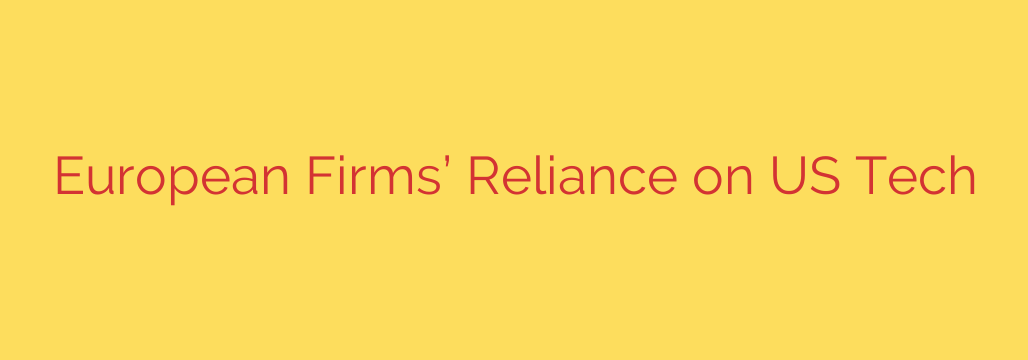
The Data Dilemma: Why European Businesses Must Rethink Their Reliance on US Tech
In today’s interconnected world, European businesses run on the powerful infrastructure provided by US technology giants. From cloud computing with Amazon Web Services (AWS) and Microsoft Azure to everyday software suites, this reliance has fueled innovation and efficiency. However, a growing tension between US law and EU privacy regulations is creating significant legal and financial risks that companies can no longer afford to ignore.
This isn’t just a theoretical problem for lawyers; it’s a practical challenge that impacts data security, customer trust, and your company’s bottom line. Understanding this digital tightrope is the first step toward protecting your business.
The Core of the Conflict: A Clash of Laws
At the heart of the issue are two powerful but conflicting pieces of legislation: the EU’s General Data Protection Regulation (GDPR) and the US CLOUD Act.
- The GDPR is designed to give EU citizens robust control over their personal data. It strictly limits how data can be processed, stored, and transferred outside the European Union, imposing severe fines for non-compliance.
- The US CLOUD Act, on the other hand, grants US authorities the power to compel American tech companies to hand over data they control, regardless of where in the world that data is stored.
This creates a direct legal paradox for European companies. A US-based cloud provider operating in Europe can be legally obligated by US authorities to disclose data, which would simultaneously be a direct violation of the GDPR. For businesses using these services, this means your data is subject to jurisdictions and laws far beyond your own.
Real-World Risks for Your Business
The invalidation of the Privacy Shield agreement by the “Schrems II” ruling in 2020 brought this conflict into sharp focus. The European Court of Justice determined that US surveillance laws did not provide adequate protection for the data of EU citizens. This decision effectively removed the primary legal framework many companies used for EU-US data transfers, leaving them in a state of uncertainty.
The risks of inaction are substantial:
- Massive Financial Penalties: GDPR fines can reach up to 4% of a company’s global annual turnover. Regulators are increasingly scrutinizing data transfer practices, and non-compliance is a costly mistake.
- Reputational Damage: Customers are more aware of data privacy than ever before. A data breach or a compliance failure linked to unlawful data access can permanently erode trust in your brand.
- Operational Disruption: If data transfers are suddenly deemed illegal, it could disrupt critical business operations that rely on cloud-based services, from CRM systems to data analytics platforms.
Actionable Steps to Mitigate Your Risk
While completely decoupling from US technology is unrealistic for most businesses, sitting back and hoping for the best is not a viable strategy. Proactive measures are essential to navigate this complex environment and demonstrate due diligence.
Here are key security and compliance steps every European business should consider:
Conduct a Comprehensive Data Audit: You cannot protect what you don’t understand. Knowing exactly where your data resides, which vendors process it, and how it is transferred is the critical first step. Map your data flows and identify every point where data leaves the EU.
Implement Strong Encryption and Key Management: Encryption is one of your most powerful defenses. Critically, you should explore solutions where you, not the cloud provider, control the encryption keys. Technologies like “Hold Your Own Key” (HYOK) ensure that even if a provider is compelled to hand over data, it remains unreadable without your explicit involvement.
Scrutinize Vendor Contracts and Data Processing Agreements (DPAs): Don’t just sign the standard agreement. Read the fine print carefully. Look for specific clauses detailing how the provider will respond to government data requests. Push for transparency and contractual safeguards that align with GDPR requirements.
Explore European Alternatives for Sensitive Data: While the major US providers dominate the market, a growing ecosystem of European cloud and software-as-a-service (SaaS) companies exists. For your most sensitive data—such as health records, financial information, or intellectual property—consider hosting it with a provider that operates exclusively under EU jurisdiction.
Consult with Legal and Cybersecurity Experts: The legal landscape is constantly evolving. Regular consultation with experts specializing in data protection law and cybersecurity is crucial to ensure your strategies remain compliant and effective against emerging threats.
Charting a Secure Digital Future
The deep integration with US technology is a reality of modern business, but it doesn’t have to be a blind dependency. By taking a proactive, security-first approach, European companies can manage the associated risks. The goal is not to eliminate US tech but to build a resilient and compliant digital strategy. By understanding the legal landscape and implementing robust technical safeguards, you can protect your data, maintain customer trust, and confidently navigate the future of global technology.
Source: https://go.theregister.com/feed/www.theregister.com/2025/09/25/three_four_european_companies/








